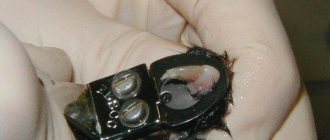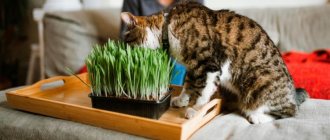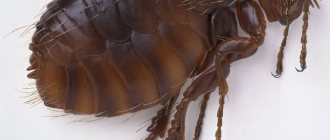The owners of their furry, mischievous pets are constantly in playful resistance with their four-legged friend. It’s a constant thing, especially for felines, to stick your nose in somewhere you shouldn’t. Usually the subject of hunting is indoor plants. Animals tear up the soil, gnaw flowers and foliage, and throw pots off window sills. The house begins to become pure chaos: the owner screams, the cat rushes from side to side, not knowing where to hide. Today we will look at the method of scaring away four-legged pets through plants.
How to protect flowers from a cat: how to scare away the animal
A pet in an apartment requires the attention of its owners. Dogs and cats often cause a lot of trouble for their owners. For example, cats can damage indoor plants.
They rummage through pots, “confusing” them with the tray, and chew stems and leaves. During play or due to carelessness, an animal may even turn over a pot with an indoor flower onto the floor. All this can be avoided if you think in advance about how to protect flowers from increased attention from your pet.
The problem is solved in two directions. On the one hand, it is necessary to rid the cat of the bad habit of spoiling plants, on the other hand, it is necessary to make such contacts impossible.
To wean your pet from the habit of “flirting” with flowers, you need positive reinforcement for correct behavior and negative reinforcement for prohibited actions.
An important point: you can’t hit cats. These capricious animals rarely associate physical impact with their behavior, and may simply become offended by their owners.
As a negative reinforcement, the fluffy can be slightly frightened. As soon as the owner notices that the cat is showing the “wrong” interest in a house plant, you can make a sharp sound: a whistle, a knock, a bell.
For this method to bear fruit, you will have to spend time. It is necessary to monitor every approach of the cat to the windowsill, otherwise a new conditioned reflex may not form.
You can build an unstable pyramid of tin cans near the pots. It is likely that the cat will knock it over and next time will be afraid to approach the potty.
You can scare a cat away from indoor plants using scents. Cats really don't like citrus scents. You need to take fresh lemon or orange juice, moisten a few pieces of cotton wool with it and put them in the pot. Over time, the smell disappears, which means the cotton balls need to be periodically replaced with fresh ones.
Adhesive tape
According to their instincts, cats do not like sticky surfaces. Just like foil, a strip of adhesive tape should be applied in a thin layer on top of the ground. The cat obviously won’t like the fact that his paws are stuck, and he definitely won’t want to repeat the attempt to crawl into the flower a second time.
When watering, you will also need to lift the tape. This option is not suitable only if the pet likes to chew bags. This method can harm his health and will have to be abandoned.
Use of special means
At the pet store you can purchase special preparations that help protect flowers from cats.:
Read also Baked eggplants for the winter for freezing
As a rule, the preparations are sold in the form of a spray, which is sprayed onto the surface of the soil and next to the pot where the flowers grow. If the animal is already old, it is better to use other methods so as not to provoke allergies, painful reactions from the bronchi, etc.
The use of substances with a pungent odor (vinegar essence, medical alcohol, vodka, etc.) is also undesirable. This poses a threat to both the health of the cat and the growth of flowers.
Terrarium
You can purchase a plant terrarium that opens from the side. This accessory will completely protect indoor flowers from animals. But it is important to remember that not all species can be grown in a closed terrarium.
Succulents are not suitable for growing in a terrarium. They do best in open containers. It is better to choose plants that tolerate high humidity well. After all, the terrarium develops its own ecosystem with a certain level of moisture. Species such as nephrolepis, dwarf ficus, begonia, pilea, and mini ivy are ideal.
Choosing the right flowers for a house with a cat
Care should be taken to ensure that contact between the animal and flowers does not harm the health of the pet. We are talking about poisonous plants. Many beautiful house plants have poisonous sap.
If a cat chews such a plant, there is a high risk of food poisoning. At the first suspicious symptoms, the animal should be taken to the veterinarian.
If the owners doubt that they will be able to wean the animal from the habit of gnawing flowers, the following representatives of the flora should be especially carefully isolated:
- dieffenbachia;
- oleander;
- philodendron;
- calla;
- spurge;
- begonia;
- hydrangea;
- ivy, etc.
To completely guarantee the safety of your four-legged friend, you can completely abandon these varieties and give them to friends who do not have pets.
Fright
If none of the previous life hacks worked, then you can use this method. The main thing is to be careful, because if the animal is greatly frightened, it will lose trust in its owner.
Noticing that the cat is approaching the potty, you need to make a sharp but quiet sound. This will scare the pet and he will walk around the flower with fear.
In these simple ways you can stop your cat from spoiling your house plants. There is no need to try all methods at once. It’s worth choosing one life hack and trying it out; if it doesn’t work, then try the next one. This way the ideal option will be found!
Deterrent fume
- Do not forget that felines have a poor sense of smell, so they cannot tolerate strong odors. You can use the sim. It is enough to take alcohol, a table bite, that is (i.e.) the zest of any citrus fruit. As an alternative, it is recommended to use black, pink, allspice and red pepper.
- You can use essences and citrus esters. Alcohol tinctures and fresh citrus peels are suitable. It’s also easy to make your own natural repeller for furry pests.
- It is enough to soak a cotton pad with a bite or alcohol. Keep in mind that such a palliative is only temporary. After the smell evaporates, the four-legged confidant can again take up old business. Therefore, every time you have to prepare a new trap.
Development cycle, features
It is interesting that the eggs of the parasite are released from the cat’s body not with expectorated bronchial sputum, which would be quite logical, but with feces. The eggs get there along with swallowed sputum. It is curious that they, once released into the external environment along with sputum (if the cat has not swallowed it), do not pose a danger. This is explained by the fact that the shell of the eggs must be “treated” with the digestive secretions of the animal.
When feces dry out and are spread across the land by wind and water, they can be eaten by land (or aquatic) mollusks, as well as other living creatures that can act as an intermediate host for helminths. In their body, the larvae mature to the required stage. If a cat simply eats the eggs of the parasite, infection will not occur (this, of course, does not apply to Capillaria aerophilia).
Once in the digestive tract, the larva breaks through the intestinal walls and, gnawing its way through the lining of the blood or lymphatic vessels, reaches the lungs along with the blood or lymph flow. Note that the clinical picture does not develop immediately: the subclinical form lasts up to six months. It is believed that the duration of the clinical form can reach two years. After this period, if the animal is not infected again, self-healing occurs due to the death of parasites due to age-related reasons.
How to stop a cat from eating house flowers
Indoor plants can be sprayed with various compounds, the taste of which the cat will not like. There are special sprays that can be bought at a pet store.
You can also prepare a repellent yourself. To do this, add aloe juice, red pepper, and sour apple juice to a spray bottle with water. Plants treated with this composition will become unpalatable to the cat.
However, before spraying, you need to make sure that the substance will not harm the flower. To do this, the composition is tested on 1-2 leaves, and only then the whole flower is treated.
Spray with repeller
As a rule, this is the first advice given to novice cat breeders.
Pet stores sell special sprays, the contents of which need to be sprayed onto the flower, after which it will begin to smell, most likely of citrus. They say cats can't stand this smell. In fact, most cats really don't like it. But this is only the first time until they get used to it. Especially if the owner often eats citrus fruits, the cat gets used to them quite quickly. This does not mean that he will experience a high from them, but this smell may not hurt to torment the flower.
And some cats not only have a normal attitude towards citrus fruits, but even love them. On one of the zoo forums, I saw a complaint from a cat owner who grew lemons at home, but couldn’t eat them: the cat ate everything.
https://fb.ru/post/pets/2020/1/22/177641
https://murkotiki.com/zaschita-tsvetov-ot-koshki
Homemade repellent
Citrus peels can be successfully replaced with essential oils. Just dilute a few drops in water and the cat repellent is ready. To enhance the effect, the mixture is sprayed in the air next to the plants, or you can sprinkle the soil in the pot. It is necessary to ensure that the liquid does not get on the plant itself.
IN THE PHOTO: A small container with a spray bottle is perfect for storing cat repellent.
To prepare a spray to save flora, you need to mix:
- 60 ml. water;
- 2 drops of lemon essential oil;
- 2 drops of wild orange essential oil;
- 2 drops of lavender essential oil.
Citrus
It is a well-known fact that cats cannot stand the smell of citrus fruits. When the owner takes hold of the orange, the cat immediately disappears. Why does this happen? The peel of citrus fruits contains essential oils and when pressed they release and splash to the sides. Cats have a very sensitive sense of smell, so such odors are very pungent and unpleasant for them.
To stop your cat from climbing into flowers, simply soak cotton wool in freshly squeezed citrus juice. Essential oils are not suitable here; it is important to use only natural juice. Wet cotton wool should be placed in a pot. The smell will scare away the cat, and he will not stick his nose into the pot. If the smell is lost, the cotton wool needs to be changed.
How to let a cat dig in a pot
To prevent your fluffy from “confusing” a flower pot with his toilet, you should limit his ability to dig in the ground. To do this, various obstacles are placed in the pot, which nevertheless allow water to pass freely during watering.
To protect against cats, they most often use:
- large stones or crushed stone. This barrier also has decorative properties. Beautifully placed stones add additional aesthetics to a potted plant;
- large sea shells;
- Pine cones. Such a barrier is not very effective, since the cat can easily push the cone to the side;
- aluminium foil. Cats really don't like walking on this material. The disadvantage of the method is its unaesthetic appearance;
- Double-sided tape. Upon contact, the adhesive tape will stick to the paws, which is unlikely to be pleasant. The animal will remember this and will avoid such an obstacle in the future. It is also important to accustom the animal to the tray. If your pet categorically refuses to acknowledge its toilet, you should analyze the origins of this behavior. A furry pet ignores the tray intended for it for the following reasons:
- insufficient cleanliness. Cats don't like to go into a dirty litter box. If the owners neglect this factor, the pet will try to find another place for the toilet;
- inconvenient location. If the cat cannot easily approach the litter box at any time, he will most likely look for an “alternative” option. Also, fluffies do not like to visit the toilet located in a place that is too accessible;
- uncomfortable tray. It should be easy for the cat to climb in and out of the container with the filler;
- presence of a second animal. If one of the cats visits the litter box, but the other does not, you need to provide the second pet with a “personal” toilet;
- tray material. Some types of plastics emit an unpleasant odor. You should purchase containers made from quality materials.
Let's watch a useful video about protecting indoor plants from pets:
Stones
To prevent the cat from being attracted to the ground, you need to pour stones on top. Both large crushed stone and small stones are suitable. In this way, the flower will not only be protected from the clever paws of a cat, but also decorated.
The main thing is not to harm the flower and not to press stones deep into the ground. The stones allow water to pass through freely, so there will be no problems with watering the flowers.
Using foil and tape
Placing foil or tape on the ground (sticky side up) will make your cat feel uncomfortable when she steps on it. The foil rustles unpleasantly, and the paws begin to stick to the surface of the tape. Therefore, next time the desire to approach the flowers will disappear.
However, this method has a drawback: foil, tape and other similar materials significantly spoil the appearance of pots with plants. And during watering, you have to constantly remove the ribbons so that the water reaches the roots. Another drawback is that the foil gets very hot in the sun and can overheat the flower.
Use hanging planters
You can use hanging pots. This will help you keep plants away from animals. Try to hang the pot high enough so that the cat cannot reach or jump to the flower.
Few people knew that Agutin had an eldest daughter. Polina looks so much like her father
It's not about allergies: why children's clothes should not be washed with conditioner
Urgent price rise: suppliers warned of a 78% rise in sugar prices
You can also place the pots in macrame planters and hang them from the wall or ceiling. But make sure that the wicker product does not contain hanging decorative elements. Otherwise, the cat will start playing with them and throw off the potty.
Hanging planters keep plants out of reach of animals. But it cannot be ruled out that leaves and flowers will end up on the floor and the cat might pick them up. Therefore, you need to give preference to safe and non-toxic plants.
Flower protection frame
To give your cat less opportunity to come into contact with house plants, flowers can be hung on the walls in pots. If the cat is dexterous and persistent and gets plants even in hard-to-reach places, the flower can be placed in a bird cage.
This rather original solution will diversify the design of the room and solve the problem of a pet encroaching on its favorite flower.
Erecting obstacles
If the animal does not chew leaves, but simply digs the ground and bites the roots, you can simply place large pebbles, crushed stone and other heavy stones on the surface of the soil. However, it will be necessary to loosen the soil more often, otherwise the flower will begin to develop worse due to the lack of oxygen reaching the roots.
There are other methods of protection:
- You can simply put the plants in a hard-to-reach place: this is the most effective protection of flowers from cats, although, unfortunately, it is not always possible in a city apartment.
- If space allows, you can make a small flower garden: fence off all the plants by erecting glass partitions. With the help of effective lighting, such a “room” will decorate the house well and fit into almost any interior.
- Interestingly, some flowers can also be hidden in a special glass flask (purchased in a special store). As a rule, cacti are protected in this way. A small stone is poured onto the ground, which creates the impression that the flower is growing in an “aquarium”.
© shutterstock
Placiterium staghorn
If you have a cat at home, then try to choose suitable types of plants for landscaping. For cat owners, the staghorn fern is ideal. In nature, it grows on tree trunks and branches. At home, platicerium is grown on vertical blocks that can be mounted high on the wall.
What is worth seeing in Sao Paulo: the inimitable Ibirapuera Park
Traveling for your love: what type of vacation to choose to strengthen your relationship
The penalty for laziness: how to maintain high productivity with low motivation
Platycerium staghorn is an unpretentious plant. It requires watering only once a week. The leaves of this fern contain no toxins and are safe for cats.
Use wall planters
You can keep plants in wall planters. These devices look like round plates. Mount them high on the wall and your flowers will be inaccessible to animals.
Remember that not all plants can be grown in wall planters. This method of maintenance is suitable for unpretentious species (succulents) with hanging or creeping shoots.
Alternative methods of protecting plants from cats
An alternative method of dealing with the problem is adjusting the cat's behavior. Your pet should be encouraged in every possible way for correct behavior. If a cat, who often spoiled a flower, passed by the pot indifferently, you should immediately praise him in a gentle voice and give him something tasty.
If the owner sees that the cat is approaching the flowers, he should switch his attention to another object. It is important to diversify your pets' leisure time. There are quite a few events in their lives. You should pay attention to playing with the animal, purchase interesting toys with which the cat can entertain itself.
You also need to give the animals the opportunity to sit on the windowsill and watch what is happening on the street.
Raising a pet
There is a longer, albeit quite effective way: the cat just needs to be trained so that it does not climb on the windowsill and especially not go near the flowers. A fairly strong stimulus is used, which forms a negative conditioned reflex. For example, as soon as the cat approaches the flower, turn on the vacuum cleaner at full power: the animal will get scared and immediately run away.
© shutterstock
Some owners also resort to more severe measures: they hit the pet on the head or body, but this method has a bad effect on further communication with the cat. She may become unsure of herself, become depressed, and even start acting out. If your cat digs and bites flowers too often despite being punished, this is likely an indication that your cat is under extreme stress.
Clean the cat's litter box
If your cat uses pots with soil and plants as a toilet, then you need to pay attention to the cleanliness of her litter box. It is possible that you rarely clean it. Try to replace the filler and remove dirt on time.
Seven daily habits of happy people
Only on a soft spot: Russian Domostroy forbade punishing children in any other way
The star of the series “Sultan of My Heart” spoke about the choice of his future wife
Sometimes cats refuse to go into a clean litter box, but show interest in flower pots. In this case, you need to choose a different type of cat litter.
Overlays from regular bags
Lids for flower pots do not have to be fabric. If the flower requires frequent watering, they are not very convenient. You can cut the cover from the bag in the same way.
To prevent mold from growing under the plastic lining, you must cut several ventilation holes in it.
I liked this option because you don’t have to pull the pad back and forth, but rather water the flower directly with it.
Cat-safe houseplants
For those who love both animals and flowers, you should choose plants that will not harm your pet. All types of house cacti are safe for cats.
Of course, with close contact there is a risk of being pricked by a needle, but this will once again force the cat to avoid representatives of the flora. The same can be said about roses. A beautiful flower will decorate any apartment and take care of safety thanks to its thorns.
Also, animal lovers can safely plant coleus, arrowroot, violets, mint, chlorophytum, crassula and many others at home.
Sticky or rustling materials
Some housewives think that by closing the window with curtains, they blocked the cat's path to the windowsill. Actually this is not true. The cat will get to the pot quickly, and you will not be able to admire your favorite plant with the curtains closed.
Alternatively, you can spread foil around the flower pot. Cats love to play with this material, but are afraid to step on it. You can also use double-sided tape. Having first removed the top layer from it. True, there is a small drawback when using this protection option. Cats are agile creatures and can easily jump over obstacles. Therefore, the barricade will have to be erected over a large area.
Folk recipes
White vinegar is a remedy that can eliminate even old odors. To prepare the solution, mix water and vinegar in a 1:1 ratio. Then you should wipe the urine with a regular rag and only then rub the prepared solution into the stain. Vinegar completely neutralizes the ammonia smell coming from urine. After some time, do not forget to wipe the treated area dry.
Cleaner (enzymatic). You should wash the urine dry and treat the area with a ready-made product. It contains special biological enzymes that quickly break down proteins in urine, thereby instantly eliminating unpleasant odor. An enzymatic cleaner can always be purchased at a specialty store. The product is great for removing odors from upholstered furniture and bed linen.
Apple cider vinegar should be mixed equally with regular laundry detergent, applied to the dirty area, rubbed in thoroughly and left to act for several minutes. After this, remove the product with a regular rag.
Bleach (no ammonia)
Wash the contaminated area with a regular cleaning agent and remove with clean water, wipe dry and treat with the prepared composition: mix water and bleach (1:10), pour into a spray bottle. Use the product very carefully, since the chlorine contained in it can ruin the color and surface structure.
Iodine. Prepare a solution: stir 10 drops of iodine in 1 liter
water, then use it to treat the contaminated surface, leave for 10 minutes and wipe dry.
Soda. Sprinkle the surface with regular baking soda. This natural product perfectly absorbs any odors. If the contaminated area is small, just rub soda into it with a sponge and leave for several hours, vacuum and wash with water. Squeeze the juice from the lemon, apply it to a cloth and gently clean the dirty area.
Mix dishwashing liquid (2 tsp) with 0.5 tbsp. hydrogen peroxide. Apply it to the contaminated area (previously sprinkled with soda). Rub the solution thoroughly until foam is obtained, then allow to dry, vacuum and remove any remaining product with clean water.
Mouthwash. First, remove the urine and wipe the surface dry, apply rinse aid to the stain, let it dry, repeat the procedure.
Potassium permanganate is a strong oxidizing agent and an excellent deodorizing agent. Prepare a weak solution and treat the contaminated area with it, let it dry. Repeat cleaning (washing) several times until the cat smell disappears completely.
Among the most effective folk remedies are sleeping tea and Lenore.











